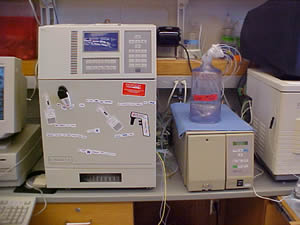Laboratory Resources
γ-Carboxyglutamic Acid Analysis
The amino terminal domain of all vitamin K-dependent coagulation proteins contains 9-12 glutamic acid residues that undergo a characteristic post-translational carboxylation at the gamma-carbon; this carboxylation is the hallmark of these proteins. These γ-carboxyglutamic acid (or Gla) residues are necessary for calcium binding which induces a conformational change in the Gla domain required for phospholipid binding. Chemical Gla analysis is carried out in our laboratory according to the modified method of Price (Price, P.A. (1983) Methods Enzymol 91, 13-17) for alkaline hydrolysis, and separation of amino acids is accomplished using a DC-4A cation exchange column on a Waters LC-1 Plus HPLC as described by Przysiecki (Przysiecki, C.T., et al. (1987) Proc Natl Acad Sci USA 84, 7856-7860). All recombinant vitamin K-dependent proteins produced in our laboratory are subjected to this type of analysis.

Mammalian Tissue Culture
The production of recombinant blood coagulation proteins in mammalian cells represents a major effort in the laboratory. We currently use HEK293, BHK, or COS cells to produce a variety of recombinant blood clotting proteins. Standard tissue culture techniques are employed to maintain and propagate cell lines. Conditioned media is collected in processed in our facility for downstream protein purification.
Protein Characterization
A variety of assay systems are employed in the laboratory to characterized blood coagulation proteins. In certain instances, protein samples are assessed for their ability to function in PT or aPTT-based clotting assays using a STAT-4 coagulation instrument from Diagnostica Stago.
We also analyze the functional activity of a variety of enzymes using chromogenic based assays using small synthetic substrate and employing a kinetic microplate reader (Spectromax 190, Molecular Devices).
A variety of other physical techniques used in the laboratory include: steady state fluorescence measurements, analytical ultracentrifugation, mass spec, and calorimetry.
Protein Purification
The purification of plasma-derived and recombinant proteins is achieved by a variety of techniques including ion exchange, affinity, and gel filtration chromatography. Preparative chromatographic separations are developed and optimized using a BioCad Sprint system or a Pharmacia FPLC system.